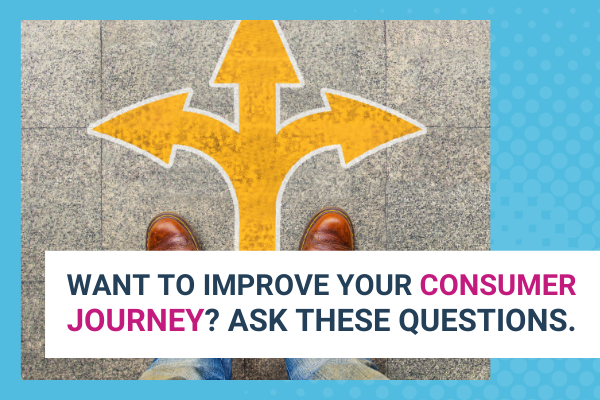What is it that your customers really want? How can you make sure you’re offering products or services that serve your customers’ needs? It all comes down to the consumer journey. Your consumer journey is the roadmap customers follow from brand awareness to the post-sale process. By improving this journey, you ensure your customers have an outstanding experience, return to your business, and refer others.
While most companies know the power of the customer roadmap, many fail to actually improve it for themselves. What’s holding them back? In short, they don’t know how their customers really feel. It’s easy to guess what your customers think, but it’s more impactful to actually walk in their shoes and see for yourself.
When you improve your customer journey, you improve the overall customer experience. With more competition than ever before, you can’t overlook this clear roadmap your customers take. By bridging the gap between the current customer journey and your ideal customer journey, you anticipate customers’ needs before they occur.
With 88% of businesses prioritizing the customer experience, the journey has never been more essential. Luckily, it’s not rocket science to improve your consumer journey. However, you need to think smarter (not harder). To start, ask yourself these important questions. From there, you’ll develop a winning strategy that leverages your unique brand superpower.
- What problem or need are you trying to meet with your product/service?
- What does your ideal customer look like?
- Where are your ideal customers already active?
- What obstacles/objections do your ideal customers have to overcome before making a purchase?
- How often do you engage with customers pre- and post-purchase, and how?
- How likely are customers to recommend your brand?
- Understand the Consumer Journey
What problem or need are you trying to meet with your product/service?
To begin, what problems or needs are you trying to meet with your product or service? These are customer pain points, and they’re essential to the overall experience. From a sales standpoint, you want to uncover and understand these pain points so you can market your solution effectively.
When you know what your customer is concerned with, you can tailor pitch the solution. That being said, pain points aren’t one-size-fits-all. There are many different types of pain points your customers might have:
- Productivity: Your customers are wasting their time on a time-consuming task. If you offer a product or service that gets this done faster or more effectively, you’re on the right track.
- Financial: If customers are spending too much money on a specific solution, they might be looking for an affordable alternative. If your competitor is more expensive, for example, this could be an easy pain point to address.
- Process: Customers also sometimes have issues with existing processes. It could be poorly managed or challenging, and a new solution saves them time and stress.
- Support: Lastly, customers need support throughout the entire journey. If they don’t know how to solve a problem, this is another pain point.
Before you do anything else, you need to have a deep understanding of your customers’ pain points. This is at the foundation of your consumer journey. Uncovering pain points is simple: ask them! Ask your customers what they struggle with, and learn about their unique experience.
One example of a company that meets its customers’ pain points is Wrench. This is a car repair service that brings the auto shop to you. Wrench knew their customers wanted a productive solution to an annoying problem (fixing or maintaining a car). Nobody wants to spend hours at an auto shop, so Wrench offered a simple solution.
By bringing certified, trusted mechanics to the consumer at their workplace or home, car repairs become hassle-free and convenient. Because Wrench identified a unique pain point of car owners, they were able to create a real ripple in a crowded industry.
What does your ideal customer look like?
Next, what does your ideal customer look like? If you don’t know who you’re speaking to with your marketing, nobody will hear you. Many brands make the mistake of trying to appeal to everyone, but this is a waste of time. In reality, no business is truly for everyone. It’s important to have an ideal customer so you can focus on their specific needs.
With that in mind, what does your ideal customer look like? Ask yourself these questions:
- What are their budgetary concerns?
- What’s their gender?
- How old are they?
- What’s their job title?
- What industry do they work in?
- Where do they live?
- How much do they earn?
- How do they communicate?
Once you ask these questions, start creating ideal customer profiles. When you try to appeal to too many people, you dilute your offerings. You’re left with no clear marketing plan or stand-out offering. By creating customer profiles, you know exactly who you’re speaking to.
Moreover, when you create content, new offerings, and marketing materials, you can consider whether they’re the right fit. Though it might sound counterproductive to not market to everyone, it’s always better to have an engaged, interested audience than to overextend yourself.
To see the power of an ideal customer in action, look at the clothing subscription service Stitch Fix. They primarily market to American career women in their 20s to 40s. They know these educated women are busy, but they still want to look great everyday.
Though they might not have time to browse for the best fashion deals and styles, they do like to use digital tools. Stitch Fix makes it easy for these women to share their current style, upcoming occasions, and fashion goals. They save time by not needing to go shopping themselves, and they still look their best. While Stitch Fix could be marketing to teens or another audience, they’ve instead focused on women who they know benefit from their tech-savvy solution.
Where are your ideal customers already active?
Additionally, you want to know where your ideal customers spend their time. This could be a single-channel approach (like email) or a multi-channel approach (email, social media, etc). Again, there is no one-size-fits-all. Because you now know your ideal customer, it’s much easier to identify where they spend their time.
For example, if you’re marketing to teens, 85% of them say they use YouTube most often. With this in mind, you can create a marketing plan that relies on video content, highlighting exposure on this specific platform. While it’s tempting to spend time (and money) investing in all marketing channels, you should really only focus on the ones that offer the biggest exposure for your audience.
There are only so many hours in the day. Don’t waste time on channels that don’t work for your audience. The same goes for your communication tools. If your ideal audience likes to communicate via email, don’t waste time investing too much in phone support. It’s all about personalizing your consumer journey to suit your ideal customer.
To see this in action, look at Urban Outfitters. Notoriously focused on its Millennial and Gen Z audience, Urban Outfitters knows how to spend time where their customers are. The brand’s social media strategy was ranked 12th in the world by L2’S Digital IQ Index. By using user-generated content, community hashtags, and responding to tagged posts on social media, they meet their ideal customer where they’re spending their time.
Today, Urban Outfitters was even one of the first fashion brands to join TikTok. Because they knew this platform was popular with Gen Z, they needed to meet their audience in real-time. With over 1 million likes on the platform already, this is a winning strategy for a reason.
What obstacles/objections do your ideal customers have to overcome before making a purchase?
Furthermore, what obstacles stand in the way of your customers making a purchase? There can be many different things that hold them back. For instance, they might not know how to use a new tool, or it could be too expensive for their current budget. Your consumer journey should have a way to compensate for these roadblocks so customers can get over them quickly.
In other words, you need to stay one step ahead of your customer. For example, if you expect your target audience to struggle with the initial tech setup, have a clear guide to help them get started. The less friction your customers experience throughout the initial sales process, the more conversions you’ll get.
Let’s look at another example to see how a real-world company fights objections. Sling TV makes it possible for users to watch live TV without needing a costly cable subscription. However, there’s still a monthly fee, plus first-time cable cutters are likely to be hesitant to try a tech-heavy alternative.
To combat this, they have a simple free trial program so users can experience the platform for free for a week before they subscribe. Additionally, their user guides and setup videos make it easy even for less tech-savvy users to get started, no matter their device. By anticipating customer needs in advance, they overcome objections with ease and get more signups.
How often do you engage with customers pre- and post-purchase, and how?
Another way to improve your consumer journey is to determine how often you engage with customers. This doesn’t mean how often you engage with customers while they’re making a purchase. Instead, you need to focus on interacting with customers before, during, and after a sale.
Not only should you consider the right amount of engagement for your audience, but you should also personalize the way you engage. Do you use live chat, support tickets, outbound calls, surveys, interviews, or a combination of the above? It’s important to have a plan for consistently engaging with customers throughout the sales cycle.
When you have these touchpoints built into the consumer journey, you support them when they need it the most. Most importantly, you can receive real-time feedback to continue improving. While most brands wait until after a sale to check-in, this might actually be too late. Rather, you should have a strategy for connecting several times so you get fresh, meaningful answers.
For example, the grammar app Grammarly knows the power of engaging with customers. Through targeted, personalized emails, Grammarly interacts with prospects and current Grammarly Plus users. Not only is the content relevant to the particular users’ grammar habits, but it’s also a chance for the company to collect valuable information.
How likely are customers to recommend your brand?
Lastly, if you want to improve your customer journey, you need to ask how likely customers will recommend you to others. In a perfect world, every customer would recommend you to their circle. In reality, this doesn’t always come naturally. Because referral leads have a 30% higher conversion rate, these are truly priceless.
Customers trust other customers. While you can sing your own praises, customers aren’t going to take you for your word. They want to hear from others they trust, like their friends, family, and coworkers. This is why it’s essential to know how likely your current users will recommend you.
The best way to leverage this data is through your Net Promoter Score (NPS). This is when you ask your customers to rate how likely they’ll recommend you based on a scale from 1 to 10. Through this rating, you identify unhappy users, passive users, and your superfans. From here, you can engage with your best customers while also nurturing those who need extra attention.
For example, the vitamin subscription brand Care/Of continually asks for current user feedback on a monthly basis. Not only do they follow up after a purchase, but they continue to check in regularly to make sure users are satisfied. If there are any problems with orders or subscriptions, they can take action right away to fix them. By being proactive, they learn in real-time and better serve new and existing customers.
Understand the Consumer Journey
From the first moment customers learn about your brand, they embark on a consumer journey. While not all users will convert into long-term customers, it’s still important to understand this journey inside and out. The better you understand who your customers are and their needs, the easier it becomes to exceed their expectations.
When you have a deep understanding of your consumer journey, you naturally create superfans. These are brand evangelists who not only continue to make purchases, but they also refer you to others. To revamp your own customer journey, start with these key questions above.






